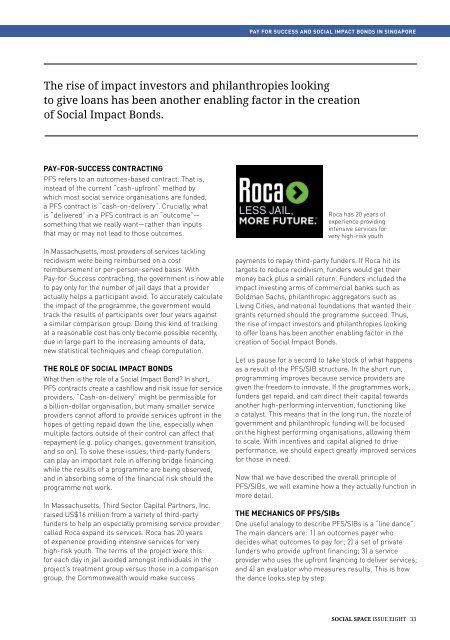Social Space (Issue 8, 2016-2017) - The Social Finance Issue
Since its debut in 2008, Social Space, the bi-annual flagship publication of the Lien Centre for Social Innovation at Singapore Management University, has provided a platform for local and international practitioners and thought leaders to share their perspectives on social innovation and entrepreneurship. Available in print and online (http://www.socialspacemag.org).
Since its debut in 2008, Social Space, the bi-annual flagship publication of the Lien Centre for Social Innovation at Singapore Management University, has provided a platform for local and international practitioners and thought leaders to share their perspectives on social innovation and entrepreneurship. Available in print and online (http://www.socialspacemag.org).
You also want an ePaper? Increase the reach of your titles
YUMPU automatically turns print PDFs into web optimized ePapers that Google loves.
PAY FOR SUCCESS AND SOCIAL IMPACT BONDS IN SINGAPORE<br />
<strong>The</strong> rise of impact investors and philanthropies looking<br />
to give loans has been another enabling factor in the creation<br />
of <strong>Social</strong> Impact Bonds.<br />
PAY-FOR-SUCCESS CONTRACTING<br />
PFS refers to an outcomes-based contract. That is,<br />
instead of the current “cash-upfront” method by<br />
which most social service organisations are funded,<br />
a PFS contract is “cash-on-delivery”. Crucially, what<br />
is “delivered” in a PFS contract is an “outcome”—<br />
something that we really want—rather than inputs<br />
that may or may not lead to those outcomes.<br />
In Massachusetts, most providers of services tackling<br />
recidivism were being reimbursed on a cost<br />
reimbursement or per-person-served basis. With<br />
Pay-for-Success contracting, the government is now able<br />
to pay only for the number of jail days that a provider<br />
actually helps a participant avoid. To accurately calculate<br />
the impact of the programme, the government would<br />
track the results of participants over four years against<br />
a similar comparison group. Doing this kind of tracking<br />
at a reasonable cost has only become possible recently,<br />
due in large part to the increasing amounts of data,<br />
new statistical techniques and cheap computation.<br />
THE ROLE OF SOCIAL IMPACT BONDS<br />
What then is the role of a <strong>Social</strong> Impact Bond? In short,<br />
PFS contracts create a cashflow and risk issue for service<br />
providers. “Cash-on-delivery” might be permissible for<br />
a billion-dollar organisation, but many smaller service<br />
providers cannot afford to provide services upfront in the<br />
hopes of getting repaid down the line, especially when<br />
multiple factors outside of their control can affect that<br />
repayment (e.g. policy changes, government transition,<br />
and so on). To solve these issues, third-party funders<br />
can play an important role in offering bridge financing<br />
while the results of a programme are being observed,<br />
and in absorbing some of the financial risk should the<br />
programme not work.<br />
In Massachusetts, Third Sector Capital Partners, Inc.<br />
raised US$16 million from a variety of third-party<br />
funders to help an especially promising service provider<br />
called Roca expand its services. Roca has 20 years<br />
of experience providing intensive services for very<br />
high-risk youth. <strong>The</strong> terms of the project were this:<br />
for each day in jail avoided amongst individuals in the<br />
project’s treatment group versus those in a comparison<br />
group, the Commonwealth would make success<br />
Roca has 20 years of<br />
experience providing<br />
intensive services for<br />
very high-risk youth<br />
payments to repay third-party funders. If Roca hit its<br />
targets to reduce recidivism, funders would get their<br />
money back plus a small return. Funders included the<br />
impact investing arms of commercial banks such as<br />
Goldman Sachs, philanthropic aggregators such as<br />
Living Cities, and national foundations that wanted their<br />
grants returned should the programme succeed. Thus,<br />
the rise of impact investors and philanthropies looking<br />
to offer loans has been another enabling factor in the<br />
creation of <strong>Social</strong> Impact Bonds.<br />
Let us pause for a second to take stock of what happens<br />
as a result of the PFS/SIB structure. In the short run,<br />
programming improves because service providers are<br />
given the freedom to innovate. If the programmes work,<br />
funders get repaid, and can direct their capital towards<br />
another high-performing intervention, functioning like<br />
a catalyst. This means that in the long run, the nozzle of<br />
government and philanthropic funding will be focused<br />
on the highest performing organisations, allowing them<br />
to scale. With incentives and capital aligned to drive<br />
performance, we should expect greatly improved services<br />
for those in need.<br />
Now that we have described the overall principle of<br />
PFS/SIBs, we will examine how a they actually function in<br />
more detail.<br />
THE MECHANICS OF PFS/SIBs<br />
One useful analogy to describe PFS/SIBs is a “line dance”.<br />
<strong>The</strong> main dancers are: 1) an outcomes payer who<br />
decides what outcomes to pay for; 2) a set of private<br />
funders who provide upfront financing; 3) a service<br />
provider who uses the upfront financing to deliver services;<br />
and 4) an evaluator who measures results. This is how<br />
the dance looks step by step:<br />
<strong>Social</strong> <strong>Space</strong> ISSUE EIGHT 33


